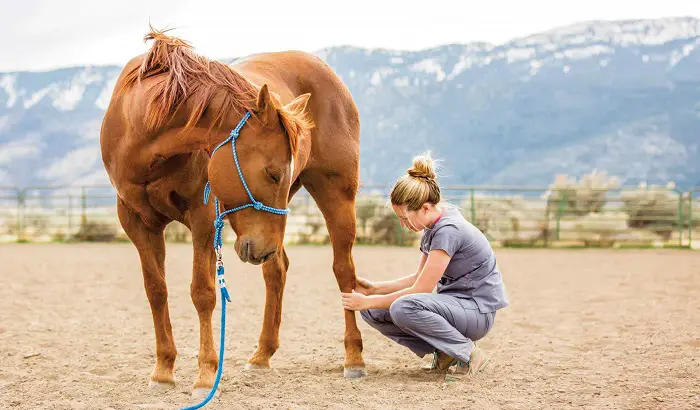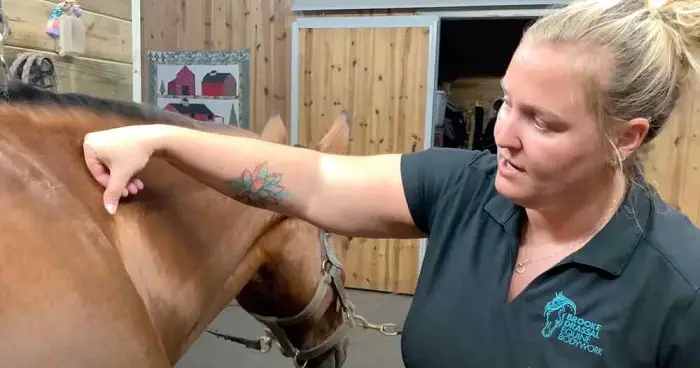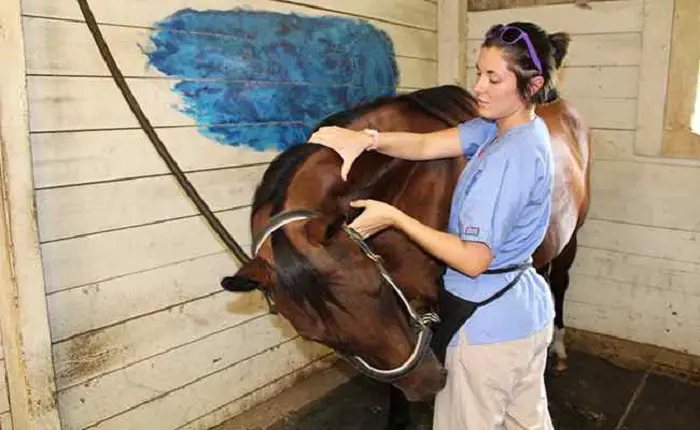Equine massage is a type of therapeutic massage designed specifically for horses. It involves using various techniques to manipulate the soft tissues of the horse’s body, such as the muscles, ligaments, and tendons, to promote relaxation, improve circulation, and relieve pain and tension.
Equine massage can be used to help maintain a horse’s overall health and well-being, as well as to address specific issues or injuries. Some benefits of equine massage may include an increased range of motion, improved performance, faster recovery from injuries, and reduced stress and anxiety.
A qualified and experienced practitioner should only perform equine massage, as incorrect or inappropriate techniques can cause harm to the horse. Ensuring the horse is properly warmed and cooled before and after the massage session is also essential.
What Does Equine Massage Do?
Equine massage is a therapy that can provide a range of benefits for horses. Some of the acute effects of equine massage include the following:
- Increased Circulation: Massage helps to stimulate blood flow, bringing fresh O2 and nutrients to the tissues of the horse’s body. This can help to promote healing and reduce inflammation.
- Improved Range of Motion: Equine massage can help to loosen tight muscles and improve flexibility, allowing the horse to move more freely and comfortably.
- Pain Relief: Massage can help release tension and reduce muscle and soft tissue soreness, relieving pain and discomfort.
- Stress Reduction: Horses, like humans, can experience stress and anxiety. Equine massage can help to promote relaxation and reduce stress levels in horses.
- Improved Performance: By addressing muscular imbalances and promoting relaxation and flexibility, equine massage can help to improve a horse’s performance in activities such as racing, jumping, or dressage.
Overall, equine massage can be a valuable tool for maintaining the health and well-being of horses, as well as for addressing specific issues or injuries. It is crucial to work with a qualified and experienced practitioner who understands the unique needs of horses and can provide safe and effective massage therapy.
What is Equine Massage Therapy?
Equine massage therapy is a form of bodywork designed explicitly for horses. It involves the manipulation of the soft tissues of the horse’s body, such as muscles, tendons, ligaments, and fascia, through various techniques to promote relaxation, relieve pain and tension, and improve overall well-being.
Equine massage therapists use their hands, fingers, and elbows to apply pressure and knead the muscles, similar to human massage therapy. They may also use tools such as rollers or massage balls to target specific areas of the horse’s body.
Equine massage therapy can address many issues in horses, from muscular soreness and tension to chronic pain and injury recovery. It can also help to improve circulation, increase flexibility and range of motion, reduce stress and anxiety, and promote overall relaxation and well-being.
It’s important to note that equine massage therapy should only be performed by a trained and qualified practitioner who understands the anatomy and physiology of horses and can provide safe and effective treatment. Equine massage therapy may be used with other forms of veterinary care to provide a comprehensive approach to horse health and wellness.
Why Does Your Horse Need a Massage?
Horses can benefit from massage therapy for a variety of reasons. Here are some of the main reasons why your horse may need a massage:
- Relief from Pain and Tension: Horses, like humans, can experience muscle soreness and tension, which can cause discomfort and limit mobility. Massage therapy can help release tension and reduce muscle and soft tissue soreness, relieving pain and discomfort.
- Injury Recovery: Horses that have suffered sprains, strains, or muscle tears may benefit from massage therapy as part of their recovery process. Massage can help to promote healing, reduce inflammation, and improve the range of motion.
- Improved Performance: Horses participating in athletic activities such as racing, jumping, or dressage can benefit from massage therapy to improve their performance. Massage can help improve flexibility, range of motion, and overall muscle function, leading to better performance.
- Stress Relief: Horses can experience stress and anxiety, affecting their behavior and well-being. Massage therapy can help to promote relaxation and reduce stress levels in horses.
- Maintenance of Overall Health and Well-being: Regular massage therapy can help maintain horses’ health and well-being by promoting relaxation, improving circulation, and reducing the risk of injury or muscular imbalances.
It’s essential to work with an experienced and qualified equine massage therapist who understands the unique needs of horses and can provide safe and effective treatment tailored to your horse’s specific needs.
Is Massage Good for Horses?
Yes, massage therapy can be very beneficial for horses. Here are some of the ways that massage can be good for horses:
- Pain Relief: Massage can help to reduce pain and discomfort in horses, particularly in areas of muscular soreness or tension.
- Improved Circulation: Massage can help stimulate blood flow, bringing fresh oxygen to the tissues of the horse’s body, promoting healing, and reducing inflammation.
- Increased Range of Motion: Massage can help to loosen tight muscles and improve flexibility, allowing the horse to move more freely and comfortably.
- Stress Reduction: Horses, like humans, can experience stress and anxiety, affecting their behavior and overall well-being. Massage therapy can help to promote relaxation and reduce stress levels in horses.
- Improved performance: By addressing muscular imbalances and promoting relaxation and flexibility, massage therapy can help to improve a horse’s performance in activities such as racing, jumping, or dressage.
It’s important to note that horse massage therapy should only be performed by a trained and qualified equine massage therapist who understands the unique needs of horses and can provide safe and effective treatment. If you are considering massage therapy for your horse, work with a reputable practitioner who can develop a treatment plan tailored to your horse’s specific needs.
What are the Pros and Cons of Equine Massage?
Equine massage therapy can provide many benefits for horses but also some potential drawbacks. Here are some of the important pros and cons of equine massage:
Pros:
- Pain Relief: Massage therapy can help to reduce pain and discomfort in horses, particularly in areas of muscular soreness or tension.
- Improved Circulation: Massage can help stimulate blood flow, bringing oxygenated blood and nutrients to the tissues of the horse’s body, promoting healing, and reducing inflammation.
- Increased Range of Motion: Massage can help to loosen tight muscles and improve flexibility, allowing the horse to move more freely and comfortably.
- Stress Reduction: Horses, like humans, can experience stress and anxiety, affecting their behavior and overall well-being. Massage therapy can help to promote relaxation and reduce stress levels in horses.
- Improved Performance: By addressing muscular imbalances and promoting relaxation and flexibility, massage therapy can help to improve a horse’s performance in activities such as racing, jumping, or dressage.
Cons:
- Cost: Equine massage therapy can be expensive, primarily if performed frequently or as part of a larger treatment plan.
- Potential for Injury: If massage therapy is performed incorrectly or by an untrained practitioner, there is a risk of injury to the horse.
- Limited Regulation: Equine massage therapy is not regulated in all states or countries, which means there may be a lack of consistent standards for training and certification.
- Not a Substitute for Veterinary Care: While massage therapy can benefit horses, it is not a substitute for proper veterinary care. If your horse is experiencing significant pain or injury, it is essential to consult a veterinarian before pursuing massage therapy.
Overall, equine massage therapy can be a valuable tool for maintaining the health and well-being of horses, as long as it is performed by a qualified and experienced practitioner and used in conjunction with other forms of care as needed.
Equine Massage Techniques
Several techniques are used in equine massage therapy, each with its own specific benefits and applications. Here are some of the most common techniques used in equine massage:
- Effleurage: This technique involves long, sweeping strokes to warm the muscles and increase circulation. It is typically used at the beginning of a massage session.
- Petrissage: This technique involves kneading and compressing the muscles, which can help to release tension and increase flexibility.
- Myofascial Release: This technique involves applying sustained pressure to specific areas of tension or restriction in the muscles and connective tissue, helping to release adhesions and improve mobility.
- Trigger Point Therapy: This technique involves applying pressure to specific points of tension or muscle pain, helping to release knots and reduce pain.
- Stretching: This technique involves gently stretching the muscles and connective tissue, which can help to improve flexibility and range of motion.
- Joint Mobilization: This technique involves gentle movements of the joints, helping to increase mobility and reduce stiffness.
- Acupressure: This technique involves applying pit point pressure to specific points on the horse’s body that are believed to have therapeutic benefits, such as reducing pain or improving digestion.
The specific techniques used in equine massage will depend on the horse’s individual needs and the goals of the massage session. Working with a qualified and experienced equine massage therapist who can develop a treatment plan tailored to your horse’s specific needs is essential.
Signs of Equine Massage is Working
Several signs indicate that equine massage therapy may work and positively impact your horse’s well-being. The most common signs are as follows:
- Increased Relaxation: One of the primary benefits of equine massage therapy is its ability to promote relaxation and reduce stress in horses. If your horse seems more relaxed and calm after a massage, the therapy has a positive effect.
- Improved Mobility: Equine massage therapy can help loosen tight muscles and increase range of motion, improving your horse’s ability to move comfortably and efficiently. If you notice your horse moving more freely after a massage session, this is a good sign that the therapy works.
- Reduced Pain and Stiffness: Massage therapy can help reduce pain and stiffness in horses, particularly in muscular soreness or tension areas. If your horse seems more comfortable and less stiff after a massage, the therapy has a positive effect.
- Improved Behavior: Horses experiencing pain or discomfort may exhibit aggression, reluctance to move, or resistance to handling. If you notice that your horse’s behavior has improved after a massage session, this is a good sign that the therapy is helping to alleviate any underlying pain or discomfort.
- Increased Performance: By addressing muscular imbalances and promoting relaxation and flexibility, equine massage therapy can help to improve a horse’s performance in activities such as racing, jumping, or dressage. If you notice that your horse is performing better after a massage session, this indicates that the therapy has a positive impact.
It’s important to remember that the effects of equine massage therapy can vary from horse to horse and that it may take several sessions to see significant improvement. If you have any questions about your horse’s health or well-being, it is always essential to consult with a veterinarian.
How Musch Pressure will you Apply During Equine Massage?
The amount of pressure applied during equine massage therapy can vary depending on the horse’s needs and preferences. It is essential to use an appropriate level of pressure that is comfortable and effective for the horse.
Generally, the pressure used during an equine massage should be firm enough to provide therapeutic benefits but not so profound as to cause discomfort or pain. The pressure should be applied gradually, using a slow and steady motion, and the therapist should constantly monitor the horse’s response to ensure that the pressure is appropriate.
Different areas of the horse’s body may require different levels of pressure. For example, the muscles of the horse’s back may require deeper pressure than the muscles of the legs or neck.
Working with a qualified and experienced equine massage therapist who can assess your horse’s needs and adjust the pressure accordingly is essential. The therapist should also communicate with you throughout the grooming session to ensure you are comfortable with the amount of pressure used and that the therapy meets your horse’s goals.
What are the Benefits of Equine Massage
Equine massage therapy offers a wide range of benefits for horses. Here are some of the most common benefits:
- Improved Circulation: Horse Massage therapy can help increase blood flow and oxygenation to the leg muscles, improving overall health and function.
- Reduced Muscle Tension: Massage therapy can help to release pressure and tightness in the muscles, promoting relaxation and reducing the risk of injury.
- Increased Flexibility: Massage therapy can help improve flexibility and range of motion in the joints and muscles, improving athletic performance and reducing the risk of injury.
- Pain Relief: Massage therapy can help to reduce pain and discomfort in horses, particularly in areas of soreness or tension.
- Improved Digestion: Massage therapy can help to stimulate the digestive system, promoting more efficient nutrient absorption and waste elimination.
- Stress Reduction: Massage therapy can help reduce stress and promote relaxation in horses, positively impacting their overall well-being.
- Improved immune function: Massage therapy can help boost the horse’s immune system, promoting faster healing and reducing the risk of infection.
- Improved Behavior: Horses experiencing pain or discomfort may exhibit negative behaviors such as aggression or reluctance to work. Massage therapy can help to reduce pain and discomfort, improving the horse’s behavior and performance.
It’s important to note that the benefits of equine massage therapy can vary depending on the individual horse and its specific needs. Working with a qualified and experienced equine massage expert who can develop a customized treatment plan that meets your horse’s specific needs and goals is essential.
Final Words on Equine Massage
In conclusion, equine massage therapy can be a valuable tool for promoting the health and well-being of horses. By releasing the tension, improving circulation, and reducing pain and stiffness, equine massage can help horses to move more comfortably and perform better in their activities.
Working with a qualified and experienced equine massage therapist who can develop a treatment plan tailored to your horse’s needs is essential. Regular massage sessions, proper nutrition, and exercise, can help keep your horse in optimal health and performance.
However, it is essential to remember that equine massage therapy is not a substitute for proper veterinary care. If you have any questions about your horse’s health or well-being, it is always essential to consult with a veterinarian.



